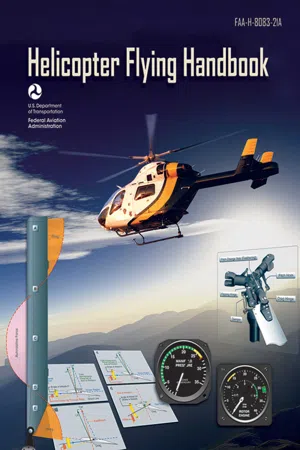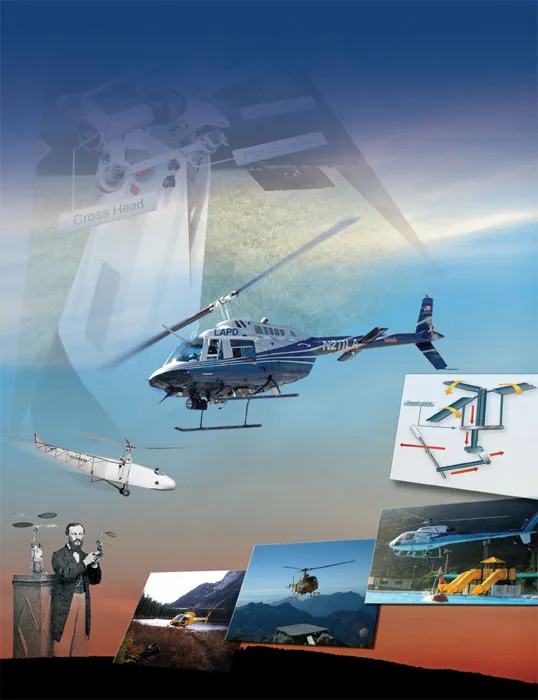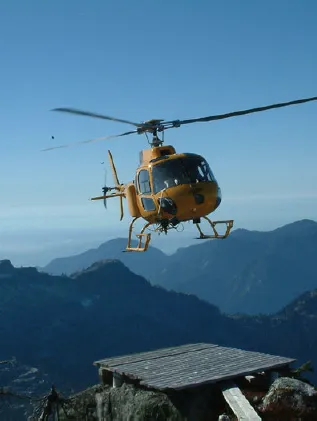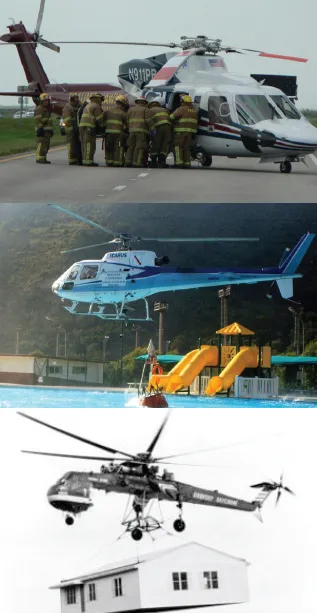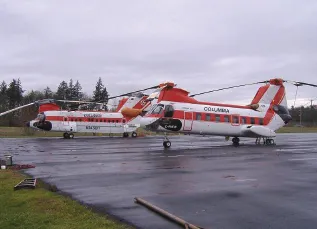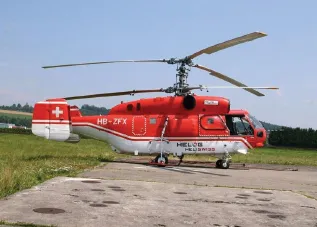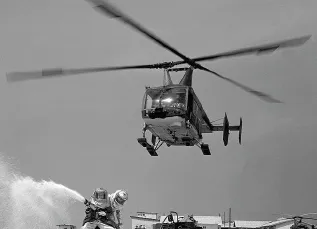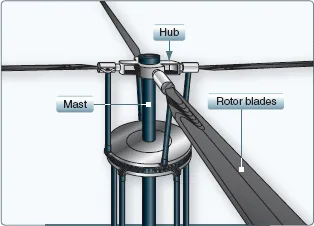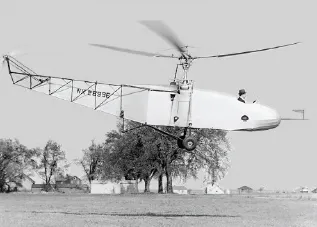![]()
Chapter 1
Introduction to the Helicopter
Introduction
A helicopter is an aircraft that is lifted and propelled by one or more horizontal rotors, each rotor consisting of two or more rotor blades. Helicopters are classified as rotorcraft or rotary-wing aircraft to distinguish them from fixed-wing aircraft because the helicopter derives its source of lift from the rotor blades rotating around a mast. The word “helicopter” is adapted from the French hélicoptère, coined by Gustave de Ponton d’Amécourt in 1861. It is linked to the Greek words helix/helikos (“spiral” or “turning”) and pteron (“wing”).
As an aircraft, the primary advantages of the helicopter are due to the rotor blades that revolve through the air, providing lift without requiring the aircraft to move forward. This creates the ability of the helicopter to take off and land vertically without the need for runways. For this reason, helicopters are often used in congested or isolated areas where fixed-wing aircraft are not able to take off or land. The lift from the rotor also allows the helicopter to hover in one area and to do so more efficiently than other forms of vertical takeoff and landing aircraft, allowing it to accomplish tasks that fixed-wing aircraft are unable to perform. [Figures 1-1 and 1-2]
Figure 1-1. Search and rescue helicopter conducting a pinnacle approach.
Piloting a helicopter requires a great deal of training and skill, as well as continuous attention to the machine. The pilot must think in three dimensions and must use both arms and both legs constantly to keep the helicopter in the air. Coordination, control touch, and timing are all used simultaneously when flying a helicopter.
Although helicopters were developed and built during the first half-century of flight, some even reaching limited production; it was not until 1942 that a helicopter designed by Igor Sikorsky reached full-scale production, with 131 aircraft built. Even though most previous designs used more than one main rotor, it was the single main rotor with an antitorque tail rotor configuration design that would come to be recognized worldwide as the helicopter.
Figure 1-2. Search and rescue helicopter landing in a confined area.
Turbine Age
In 1951, at the urging of his contacts at the Department of the Navy, Charles H. Kaman modified his K-225 helicopter with a new kind of engine, the turbo-shaft engine. This adaptation of the turbine engine provided a large amount of horsepower to the helicopter with a lower weight penalty than piston engines, heavy engine blocks, and auxiliary components. On December 11, 1951, the K-225 became the first turbine-powered helicopter in the world. Two years later, on March 26, 1954, a modified Navy HTK-1, another Kaman helicopter, became the first twin-turbine helicopter to fly. However, it was the Sud Aviation Alouette II that would become the first helicopter to be produced with a turbine engine.
Reliable helicopters capable of stable hover flight were developed decades after fixed-wing aircraft. This is largely due to higher engine power density requirements than fixed-wing aircraft. Improvements in fuels and engines during the first half of the 20th century were a critical factor in helicopter development. The availability of lightweight turbo-shaft engines in the second half of the 20th century led to the development of larger, faster, and higher-performance helicopters. The turbine engine has the following advantages over a reciprocating engine: less vibration, increased aircraft performance, reliability, and ease of operation. While smaller and less expensive helicopters still use piston engines, turboshaft engines are the preferred powerplant for helicopters today.
Uses
Due to the unique operating characteristics of the helicopter— its ability to take off and land vertically, to hover for extended periods of time, and the aircraft’s handling properties under low airspeed conditions—it has been chosen to conduct tasks that were previously not possible with other aircraft or were too time- or work-intensive to accomplish on the ground. Today, helicopters are used for transportation, construction, firefighting, search and rescue, and a variety of other jobs that require its special capabilities. [Figure 1-3]
Figure 1-3. The many uses for a helicopter include search and rescue (top), firefighting (middle), and construction (bottom).
Rotor System
The helicopter rotor system is the rotating part of a helicopter that generates lift. A rotor system may be mounted horizontally, as main rotors are, providing lift vertically; it may be mounted vertically, such as a tail rotor, to provide lift horizontally as thrust to counteract torque effect. In the case of tilt rotors, the rotor is mounted on a nacelle that rotates at the edge of the wing to transition the rotor from a horizontal mounted position, providing lift horizontally as thrust, to a vertical mounted position providing lift exactly as a helicopter.
Tandem rotor (sometimes referred to as dual rotor) helicopters have two large horizontal rotor assemblies; a twin rotor system, instead of one main assembly and a smaller tail rotor. [Figure 1-4] Single rotor helicopters need a tail rotor to neutralize the twisting momentum produced by the single large rotor. Tandem rotor helicopters, however, use counter-rotating rotors, with each canceling out the other’s torque. Counter-rotating rotor blades won’t collide with and destroy each other if they flex into the other rotor’s pathway. This configuration also has the advantage of being able to hold more weight with shorter blades, since there are two sets. Also, all of the power from the engines can be used for lift, whereas a single rotor helicopter uses power to counter the torque. Because of this, tandem helicopters are among some of the most powerful and fastest.
Figure 1-4. Tandem rotor helicopters.
Coaxial rotors are a pair of rotors turning in opposite directions, but mounted on a mast, with the same axis of rotation, one above the other. This configuration is a noted feature of helicopters produced by the Russian Kamov helicopter design bureau. [Figure 1-5]
Figure 1-5. Coaxial rotors.
Intermeshing rotors on a helicopter are a set of two rotors turning in opposite directions, with each rotor mast mounted on the helicopter with a slight angle to the other so that the blades intermesh without colliding. [Figure 1-6] The arrangement allows the helicopter to function without the need for a tail rotor. This configuration is sometimes referred to as a synchropter. The arrangement was developed in Germany for a small anti-submarine warfare helicopter, the Flettner Fl 282 Kolibri. During the Cold War the American Kaman Aircraft company produced the HH-43 Huskie, for USAF firefighting purposes. Intermeshing rotored helicopters have high stability and powerful lifting capability. The latest Kaman K-MAX model is a dedicated sky crane design used for construction work.
Figure 1-6. HH-43 Huskie with intermeshing rotors.
The rotor consists of a mast, hub, and rotor blades. [Figure 1-7] The mast is a hollow cylindrical metal shaft which extends upwards from and is driven by the transmission. At the top of the mast is the attachment point for the rotor blades called the hub. The rotor blades are then attached to the hub by a number of different methods. Main rotor systems are classified according to how the main rotor blades are attached and move relative to the main rotor hub. There are three basic classifications: semirigid, rigid, or fully articulated, although some modern rotor systems use an engineered combination of these types. All three rotor systems are discussed with greater detail in Chapter 5, Helicopter Systems.
Figure 1-7. Basic components of the rotor system.
With a single main rotor helicopter, the creation of torque as the engine turns the rotor creates a torque effect that causes the body of the helicopter to turn in the opposite direction of the rotor (Newton’s Third Law: Every action has an equal and opposite reaction, as explained in Chapter 2, General Aerodynamics). To eliminate this effect, some sort of antitorque control must be used with a sufficient margin of power available to allow the helicopter to maintain its heading and prevent the aircraft from moving unsteadily. The three most common controls used today are the traditional tail rotor, Fenestron (also called a fantail), and the NOTAR®. All three antitorque designs will be discussed in Chapter 5.
Rotor Configurations
Most helicopters have a single, main rotor but require a separate rotor to overcome torque which is a turning or twisting force. This is accomplished through a variable pitch, antitorque rotor or tail rotor. This is the design that Igor Sikorsky settled on for his VS-300 helicopter shown in Figure 1-8. It has become the recognized convention for helicopter design, although designs do vary. When viewed from above, designs from Germany, United Kingdom, and the United States are said to rotate counter-clockwise, all others are said to rotate clockwise. This can make it difficult when discussing aerodynamic effects on the main rotor between different designs, since the effects may manifest on opposite sides of each aircraft. Throughout this handbook, all examples are based on a counter-clockwise rotating main rotor system.
Figure 1-8. Igor Sikorsky designed the VS-300 helicopter incorporating the tail rotor into the design.
Tail Rotor
The tail rotor is a smaller rotor mounted vertically or near-vertically on the tail of a traditional single-rotor helicopter. The tail rotor either pushes or pulls against the tail to counter the torque. The tail rotor drive system consists of a drive shaft powered from the main transmission and a gearbox mounted at the end of the tail boom....
